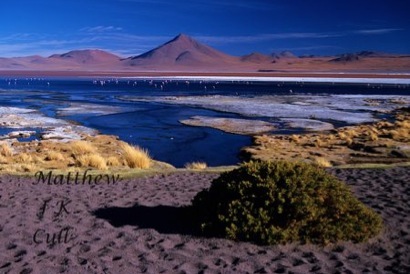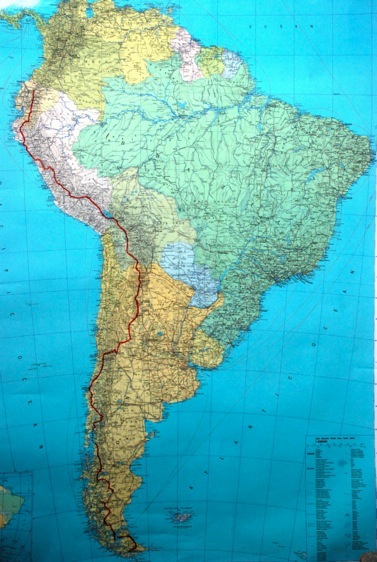Matthew J K Cull

Photographer, Speaker, Writer
World Adventure Traveler
Bicycle Journeys
South America
May 2000 to january 2001

Riding along the Andes Mountains from the Equator in Ecuador to Tierra del Fuego, at the base of South America. Mountains and more mountains, a constant spectacle of grandeur. 11,879 kms, 252 days in 5 countries, along the longest mountain range on the planet.
This blog starts in northern Peru, the journey south from the equator through Ecuador already completed.
Lousy Roads, Magnificent Scenery

CUZCO AT LAST, the fabled city of the Incas. For those of you who were wandering if I’d fallen off the map, I almost did but I caught myself at the last moment. The riding has been absolutely awesome. Some of the most difficult and demanding I have ever done, through some of the most continually dramatic and spectacular scenery to be had. I left north coast of peru about a month ago, a month that seems more like a year. I left the coast and headed up into the mountains through an arid, inhospitable but spectacular gorge into the Huaraz valley sandwiched between the Cordillera Negra and the Cordillera Blanca. I took break from bike and did a four day hike crossing the Cordillera Blanca over a 16,OOO ft pass. In the town of Chacas I caught a bus back over another absolutely stunning 16,200 ft pass (I was looking down at the glaciers) to Huaraz. It was there that the real cycling began. By comparison Ecuador was merely a warm up.
Onto rough and gnarly dirt roads, over a pair of 16,000 ft passes for four days on a road that resembled a river bed. It was 300 km of bumping, jostling, horrible roads where the daily averages rarely exceeded 10 kph. It ended with 6,000 ft, 60 km, 6 hour drop to Huanuco. Back on gorgeously smooth pavement I climbed 6,000 ft up to Cerro de Pasco, one of the highest towns in the world at 14,300 ft. My route then followed the Rio Mantaro, through Huancayo, off the end of the pavement, and along a continually spectacular gorge to Ayacucho. Ayacucho, far from anywhere in the central highlands, is a charming colonial town with a grand plaza and was once the home town of the Sendero Luminoso, the Shining Path, that was once Peru’s terrorist independence organisation.
There followed the ride to kill. 8 days of riding, 5 major climbs totaling 35,000 ft of vertical, mostly on horrible dirt roads that allowed average speeds rarely in excess of 11 kph whether going up or down. I spent hours going 3,000 to 7,000 ft, then hours going the same amount down. Days measured in horizontal distance and vertical gained and lost. Up over high passes of pampa grass, down through arid gorges to heat and sand flies. Always spectacular, always tough, always immensely rewarding. The local people were always friendly, waving and calling out with greetings as they worked in their fields, waited by the road for a vehicle, or herded their animals. Long days of tough cycling to move just one centimeter on the map.
The last 100 km into Cuzco were on sweet smooth firm wonderful pavement. I had long given my dreams of sex for dreams of pavement.

Cuzco is relaxing but chaotic and just smothered with tourists, I see more tourists in five minutes than I had seen in the previous month. I’ll be here for a week or so, doing the touristy things like hike the inca trail and visit ruins before heading on down the street to Bolivia. It’s hard to believe I have gone so little distance on the map for so much cycling.
Up onto the Plain
Down here it’s a new country, a new currency, a new landscape, but the same language, Bolivia. After the tortuous roads of Peru prior to Cuzco, roads and life straightened out and smoothed out. With smooth pavement easy gradients, little climbing and tailwinds the 700 kms from Cuzco to La Paz, Bolivia, slipped by comfortably and at an agreeable speed. From Cuzco I climbed a high pass and descended onto the Altiplano, the high plane that stretches across southern Peru and the Iength of western Bolivia and into Argentina. It would be my home for 1.5 months. A land of far horizons, big skies, thin air, brown grass and resilient folks at around 3600+ meters.
A few days fro Cuzco I came to Lake Titicaca, an enormous expanse of blue perched at the top of the world. I spent a day on a boat touring across its expanses -- just the ticket, sitting on a boat doing nothing -- to a couple of its islands. I cycled along it shores with views over the lake to the glacially capped Cordillera Real. I crossed into Bolivia and spent a couple of very relaxing days hiking along Isla del Sol, the mythological origin of Inca people. I stayed with a man who still, in spite of the overwhelming trend to wood and steel boats, makes totora reed boats. Then on to La Paz, a big city in a deep canyon just below the rim of the Altiplano. The thick crowds of the city are in stark contrast to the empty altiplano above.
After a couple of days in La Paz I took a two day hike over a high passes that crosses the divide into the Yungas region. It is a steep hilly land of thick luxuriant growth, warmth, birds, fruit trees, and verdant growth.

ARGENTINA: pavement, supermarkets, fast cars, and whole new world. I am very happy to be where the cycling is less consuming and more fun. Its that time in the trip, after 4 months, were those simple luxuries are totally appreciated. I am in Salta, in the north-west.
I was in Bolivia a month mostly cycling across the Altiplano, the second largest high altitude plane in the world. After the serene beauty of Lake Titicaca and the bedlam of La Paz it was surreal to be casting across the vast big sky country of the Altiplano: endless plains, rolling hiIls of brown grass or dry prickly scrub long straights in the road and dreary
villages out in the middle of nowhere. It was really enjoyable until the pavement ended and the sand and the washboards kicked in. Then I was down to using railway line, the local’s cycle tracks, anything to get there. Under a punishing sun and with little water i sight i cycled down to Uyuni.
I took a break from the bike there and joined a 4wd trip for four days into the far south west country into a land of immense salt flats as far as the eye can see, salt lakes in red, green, and white, with thousands of flamingos and extinct and active volcanoes in a variety of reds, yellows, pinks, oranges and whites. A wild beautiful, if inhospitable landscape. I then bused over to Potosi, once the largest city in the Americas. It was built around a huge silver mine which is still worked by bands of men working long hours in cramped dark tunnels chiseling away by hand.
Back on the bike I rejoined the terrible roads, crossing over plains and mountain passes to Tupiza and a land dominated by red ridges of rock strata reminiscent of the Moab or McDonnell Ranges. Further I came to Villazon and the border at to Argentina. I dropped off the altiplano via the Quebrada Humahuaca into the new world. It’s great to cycle from one country, culture/people, or Iandscape to another, experience the dramatic and subtle changes, especially when that change is an improvement.
I have decided that Salta is halfway in my journey. In celebration I overhauled my hubs - exciting huh?
Easy But Not Necessarily Interesting
I am now in the bustling mess of Santiago, Chile. While the western upgrade to Argentina was greatly welcomed greatly and I flew along at tremendous speeds on delightfully smooth paved roads, the landscape quickly lapsed into dreary miles of flat dry thornbush. It did make for some fast progress south and after spending days and days in Peru scratching for a degree of latitude, in Argentina I was crossing them about one a day. There was some huge olive groves to break the monotony, and in the south vineyards became all the rage around San Juan and Mendoza. To compound the mental dreariness my back reared its ugly head and made cycling and everything else very uncomfortable. It made for some interesting viewing for the locals as I pulled into towns and hobbled around, barely able to et on, or off the bike.

Mendoza, the wine capital of the country was wonderful with its abundant parks, tree lined avenues and surrounded by vineyards.
Change is a marvelous thing. I get sick of the mountains and I drop onto the plains. I get sick of the flat and climb back into the mountains. I climbed back into the Andes west of Mendoza enduring a day of near impossible headwinds, but spectacular views to cross the range at one of it narrowest points since Quito. I passed through a tunnel under the range crest passing into Chile. I stayed a couple of days in Los Andes at great house that weIcomes cyclists, some of whom stay for months. But with lakes mountains and forests ahead I continued on to Santiago.
In the Long Skinny Land
I am now in fabled and soggy Porto Montt, at the top end of Patagonia, a vast land of mountains, fjords, incredible landscapes and rain. Its the stat of a new episode in the continuing epic.
I followed Ruta 5, the biggest road in the land, south from Santiago, a couple of days of lousy riding. I turned off and rode into a vibrant green land of hills, mountains, forests, lakes, beaches, and relatively quiet roads with very friendly and helpful folks. I wound past yellow fields of flowers and and active forest products industry and hit the coast at Concepcion. I turned back inland and had a great time being invited into the homes of the local people. Three days of rain brought me to Villarica and when the weather finally cleared, there was the snow capped cone of Volcan Villarica rising above the lake.
For the next two weeks I rode south through the Lake District, never far from vast blue lakes, white capped ridges, peaks, perfect cone volcanoes, luxuriant forest and a patchwork of green fields. I passed 31 lakes, crossed several passes and crossed the Chile/Argentinian frontier twice. The roads came paved and unpaved, the skies came in blue and dark wet grey. It was idillic and wonderful cycling.

From Porto Montt, Chile, I traveled a little south by boat, Since the only road, the Carraterra Austral, had yet to open for the season. From Chaiten a narrow smooth unpaved road wound through steep forested mountains that exuded the water that fell from the sky. The weather was a continuos brew of sun, cloud, rain, and wind. Nothing stayed for long, it always kept me on edge. Steep mountainsides rose from turquoise lakes or dark fjords through thick dripping forests to snow capped peaks and the odd glacier.
But all goods road must and and rain, mountains and the Patagonian ice cap forced me to cross the Andes again out onto the Argentinian pampa. A vast open brown grassland swept continually by brutal winds that rip down off the ice cap and head for the Atlantic on its perpetual quest for pressure equilibrium. I followed the Ruta 40, a lonely strip of deep gravel, south, across the wind. Few vehicles, an isolated village or hotel, a group of sheep or guanacos, and driveways leading to ranches far from the road. My speed dwindled in the wind, my course wandering all over the road at the will of the wind, my progress imperceptible in the landscape.
I stopped in El Chaiten, home of the peaks Fitroy and Cerro Torre, but saw little in the rain howling wind and cloud. I took the side trip out to Perito Moreno Glacier. Its 6 km wide front carves continually into the country’s largest lake. I returned to Chile, and finally aided by winds that blew dust storms past me, I flew into Porto Natales.
To The End Of The World
In Peurto Natales I left the bicycle and I ventured north into Patagonia’s Flagship park, Torres del Paine. I spent 9 days walking around, and into, this towering massif. I traded the endless road for a heavy pack and a soggy trail that brought me close to its sheer towers of beige granite, its plethora of lakes in a variety of greens, blues and greys, its hanging white glaciers, its forests of southern beech, wild berries, mosses and bushes and fields of wildflowers. And then there was the Grey Glacier, a seven km wide ocean of ice pouring down from the ice cap only to dissolve in a lake of its own making. Apart from the pounding Patagonian wind and the odd shower the weather was surprisingly magnificent, enough sky to see but enough cloud to let me know i was lucky.

Back on the bike I continued into the last chapter. Pavement and tailwinds made for a happy cyclist as I continued south over a low scrubland with grass and wind battered forest. I made stops to visit friends in Rio Verde and to a penguin rookery on the way to Punta Arenas. Following the Straights of Magellan I continued south to the end of the road on mainland South America. Crossing the straights by ferry I landed on Tierra del Fuego, long the bain of mariners and the home of wealthy wool barons. With the wind on my tail I speed easily to the Atlantic ocean, the only point on the journey where I would see the ocean I’d been paralleling for months.
Turning back westward I returned to the mountains, crossing the Andes one last time to arrive at the end of the world, Ushuaia. While there was indeed more world on the other side of the Beagle Channel, for me this was the end of the road. I dismounted the bike, leant the clothes I’d been wearing the whole trip up against the corner and enjoyed the revelry of the cyclists that had come to this remote place. While in a spectacular location, Ushuaia was just another Argentinian town. But it is not the town, not the end to one which rides which is the point, but the means and the way itself. For seven months and 12,000 kms I had been working this way soaking up the land and its people with a measure of sweat toil and perseverance. Then abruptly the goal, the object was complete, there was both joy at the completed task and the promise of rest ahead, but also sadness as the adventure and the substance of this life was over. It was time to go home.
But there is always next time.
© Matthew J K Cull 2000